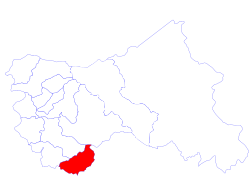Kathua district
| Kathua district | |
|---|---|
 Location of Kathua District in Jammu & Kashmir state |
|
| Country | India |
| State | Jammu and Kashmir |
| Population (2011) | |
| • Total | 616,435 |
| • Density | 246/km2 (640/sq mi) |
| Demonym(s) | Indian |
| Time zone | +5:30 IST |
| Postal code | 184101(post head office) |
| STD code | 01922 |
| ISO 3166 code | IN-JK |
Kathua district is one of 22 administrative districts that comprise the state of Jammu and Kashmir under Indian rule. It is surrounded by Jammu to the northwest, the Doda and Udhampur districts to the north, the state of Himachal Pradesh to the east, Punjab to the south, and Pakistan's working boundary to the west. Its terrain is diverse, consisting of rich agricultural areas along the Punjab/Kashmir border, plains sweeping eastward to the foothills of the Himalaya, and a mountainous Pahari region in the east.
Kathua district is divided into 8 blocks: Bani, Barnoti, Basholi, Billawar, Duggan, Ghagwal, Hiranagar, Kathua and Lohai Malhar. It has approximately 512 villages.
The traditional language of Kathua is Dogri. The Pahari languages are prevalent in the mountainous area of the east. The principal media of education are English, Hindi, and Urdu.
In a Muslim majority state, Kathua, like the Jammu district, is overwhelmingly Hindu, Total Population is 6.15 Lacs (Census of India 2001). Hinduism practiced by 91%, Muslims 7% and Sikhs 2%.
A relatively safe regional pocket, Kathua was spared the decade-long insurrection sparked by the Khalistan separatist movement in Punjab State on the Indian side of Punjab region that ended in the early 1990s, just to its south, and the ongoing insurgency in Kashmir Valley further to the north, beginning in the 1980s.
Prior to 1921, the Kathua district was known as the Jasrota district. Between 1921–1931, the headquarters of the district was shifted to Kathua without any alteration in the area of governance.
...
Wikipedia
